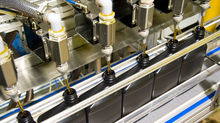Silicone Lubricant Selection in Rotary Screw Compressors - A True OEM Equivalent to Sullair's 24KT®
The use of silicone-based lubricants was introduced into the rotary screw compressor market by Sullair Corporation in 1975 with the premise of a lifetime compressor fluid, virtually eliminating replacement because of its resistance to oxidative and thermal degradation. This fluid was to be known as 24KT®. With the use of this fluid, customers would be able to extend their warranty from the common two years at the time, up to ten years – a major industry game changer.
In addition to the extended warranty, there were numerous other advantages seen by using silicone compressor lubricants:
Via its proprietary formulation and semi-organic structure, 24KT® does not break down at normal operating temperatures, with no true limitation on its useful life.
Silicone is known to coat and penetrate both metallic components as well as elastomers. This aids in the protection from rust and corrosion, protecting components.
Silicone is chemically inert, preventing fluid breakdown and avoiding varnish or sludge formation as with many other compressor lubricants.
Silicones low solubility with water allows it to perform excellently in contaminated environments where acid build-up in the compressor has proven troublesome.
OEM vs. Aftermarket Silicone Compressor Lubricants
In the years following the introduction of Sullair’s 24KT®, third-party manufacturers began to bring to market aftermarket versions of the silicone compressor lubricant. These aftermarket options did not follow the same elemental composition as 24KT, but rather focused on using various silicone base fluids to match a viscosity and then adding a rust inhibitor. The rust inhibitors used to this day, while suitable for other compressor fluids, do not solubilize in the silicone base oils. This leads to additive fallout and puts the compressor at risk for long-term rust and corrosion buildup.
General comparative evaluation of Technical Data Sheets, reviewing specifications for color, viscosity, viscosity index, low temperature viscosity and flash point will not highlight the shortcomings of the aftermarket lubricant formulations. Nor will physical evaluation of the lubricant’s appearance or compatibility testing.
Performance Differences in Fully Formulated Silicone Compressor Lubricant
Once a rotary screw air compressor is placed into service with silicone lubricant, regular top-off is typically all that is required as this type of lubricant is known to leak. With Sullair’s 24KT® List Price currently at $899 per 5-gallon pail, aftermarket lubricants are used to top-off these machines once the extended warranty has ended. Continual top-off of these lower quality aftermarket formulations do not present concern initially, but over time, as the aftermarket product becomes the predominant fluid in the machine, the limited oxidative stability will cause a once thought to be robust fluid to deteriorate rapidly. Lubricant failure takes place as a result of viscosity rise and eventual system shutdown.
Challenges with Flush & Fill Transitions to Alternative Lubricant Technologies
To transition a compressor filled with silicone lubricant to an alternative technology, the system must by drained, oil filter and separator element replaced, and then fully charged with a diester based lubricant. The machine should then be started and ran for 15 minutes. This process should be repeated two more times, with the oil filter and separator element being replaced each time. After the third flush, the lubricant of choice moving forward should be used. Further flushes with the replacement lubricant may be required if foaming persists. Some Sullair machines may also require the thermal mixing valve to be replaced as well as it is likely rated a higher temperature for the operation of the unit with a silicone-based lubricant.
With silicone's tendency to impregnate itself into a system's hoses, seals and other parts, foaming as a result of lubricant transition is widespread and persistent. It is not uncommon for service technicians to grow frustrated with this process and avoid performing silicone flushes after a number of bad experiences.
OEM Equivalent Silicone Compressor Lubricant
Through a multi-year laboratory development project and numerous field trials, a true chemical equivalent to the 24KT® has been developed. With special attention given to oxidative life, thermal stability, wear protection, and chemical composition, the SAP 9600 has been introduced to market as the first true OEM equivalent silicone compressor lubricant ever produced by a third-party lubricant manufacturer.

Conclusion
As of 2017, Sullair has announced the 24KT® will no longer be an option for use in new rotary screw compressors. This may be a result of the global shortage on silicone or the transition to a ten-year warranty for compressors using the flagship Sullube lubricant. While 24KT® will remain available for machines in the field, having an OEM equivalent alternative, such as SAP 9600 will help the industry to maximize the useful life of these compressors without being forced to return to the equipment manufacturer every time additional fluid is required.


























